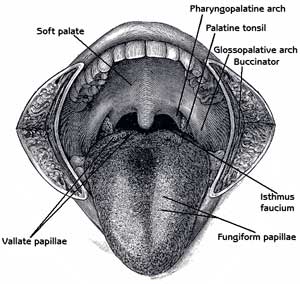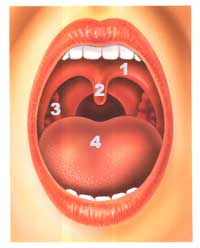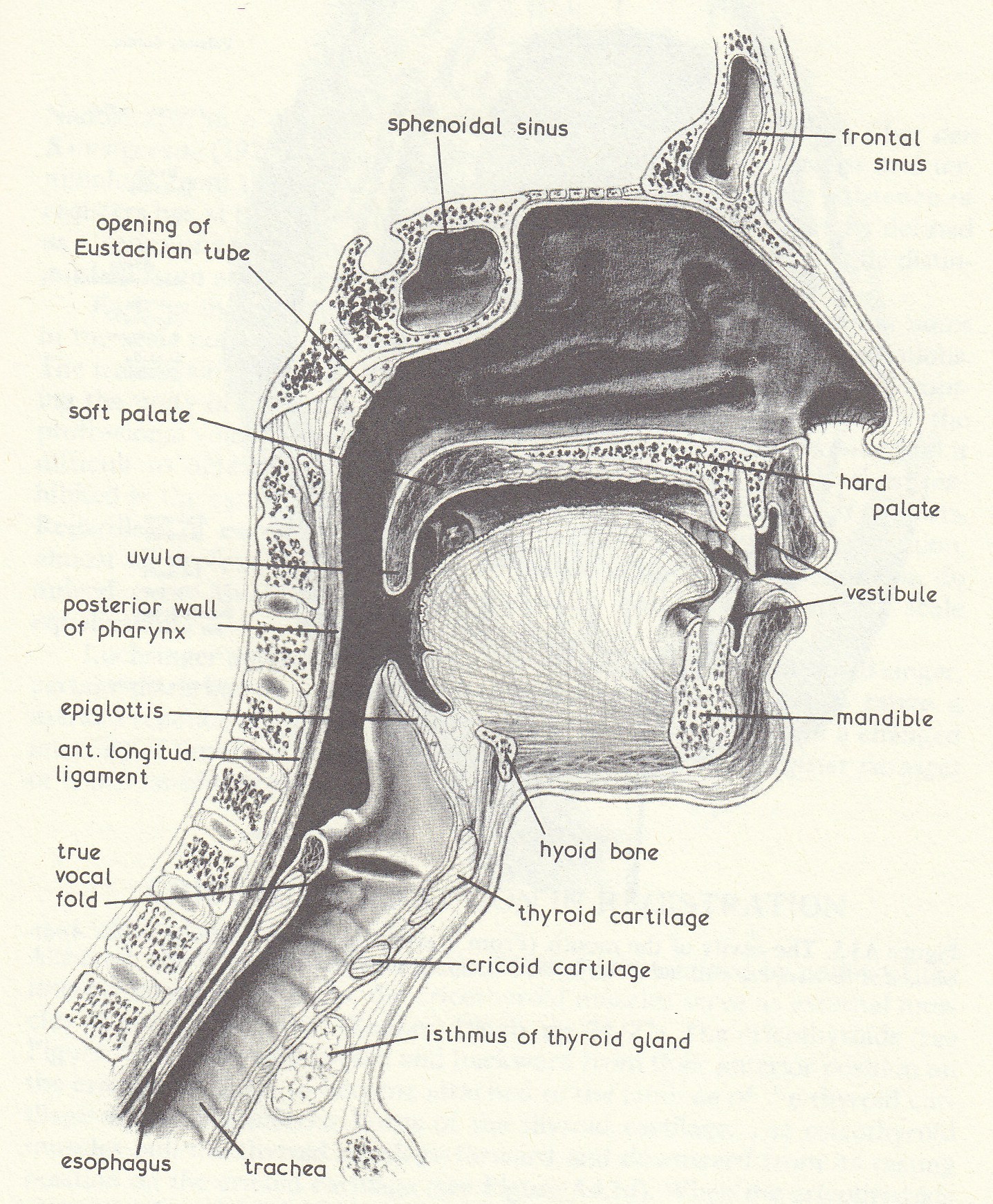|
 The soft palate, also known as the velum or muscular palate, is the soft tissue constituting the back of the roof of your mouth (it's number 1 on the diagram below). The soft palate is different from the hard palate at the front of the mouth in that it does not contain bone. You can feel this abrupt transition from hard to soft, as the name implies, if you slide your tongue or your finger along the roof of your mouth, front to back. Once you find it, move your finger side to side to feel its width. If you try yawning with your finger in place, you will feel the soft palate rise up distinctly. (Number 2 in the diagram below is the uvula which hangs from the middle of the back of the soft palate, number 3 is a tonsil and number 4 is, of course, the tongue.)
The soft palate, also known as the velum or muscular palate, is the soft tissue constituting the back of the roof of your mouth (it's number 1 on the diagram below). The soft palate is different from the hard palate at the front of the mouth in that it does not contain bone. You can feel this abrupt transition from hard to soft, as the name implies, if you slide your tongue or your finger along the roof of your mouth, front to back. Once you find it, move your finger side to side to feel its width. If you try yawning with your finger in place, you will feel the soft palate rise up distinctly. (Number 2 in the diagram below is the uvula which hangs from the middle of the back of the soft palate, number 3 is a tonsil and number 4 is, of course, the tongue.)
 The main function of the soft palate is to open and close the airway to the nasal cavity. This happens all the time during speech and yet you are unaware of it. It opens the nasal airway primarily for nasal consonants such as M, N, and NG. It opens and closes quickly and imperceptibly. You can stretch it upwards by yawning which also causes the back of the tongue and the larynx to lower and the nostrils to flair.
The main function of the soft palate is to open and close the airway to the nasal cavity. This happens all the time during speech and yet you are unaware of it. It opens the nasal airway primarily for nasal consonants such as M, N, and NG. It opens and closes quickly and imperceptibly. You can stretch it upwards by yawning which also causes the back of the tongue and the larynx to lower and the nostrils to flair.
The soft palate is therefore movable, consisting of muscle fibres covered by a mucous membrane. It is responsible for closing off the nasal passages during the act of swallowing, coughing and during all vowels (except the nasalized ones found in some languages) and most consonants. During sneezing, it protects the nasal passage by diverting a portion of the excreted substance to the mouth.
It is possible for the soft palate to raise more than it needs to, during both speech and singing. This unnecessary added tension is sometimes erroneously viewed as proper classical technique. If you try to talk that way it sounds silly, so why sing that way? The artificial raising of the palate adds tension to not only to the soft palate, but to the throat as well. Its not a technique that is viable in the long-run and makes singing in the high range difficult. Singers who are taught to do this, will experience vocal problems down the road as their voices will tire more easily and some will also develop pitch problems. Popular singers usually avoid this pitfall as popular idioms do not seek to imitate the richer, darker sound often desired by classical singers.
Contrary to what some singers are taught, air does NOT pass through both the mouth and the nose simultaneously to achieve a balanced, natural sound. During all English vowels and most French vowels (except the nasalized ones) air passes only through the mouth. There is no need to 'balance nasality' by playing around with the soft palate while singing. Sadly, this is taught under many different disguises. Doing strange things, like swallowing marbles or fish while you sing causes this fabricated sound and unnecessary throat and soft palate tension. The subsequent sound is not natural but rather fabricated. The soft palate closes off the nasal passage during vowels and many consonants without you having to intervene in any way, both in speech and in singing. You don't consciously raise it while you speak, so please don't do so while singing. Doing so gives a "cheap" classical sound. The richness you are seeking is achieved in another way
(see Resonance,
Alignment, and
Pharynx).
Exercises designed to connect your speaking voice with your singing voice will help avoid these pitfalls and reward you with a rich, natural sound.

For more information or to book a private lesson,
please call: 514.295.1850
or email:
info@vocaltechnique.ca
|
 The soft palate, also known as the velum or muscular palate, is the soft tissue constituting the back of the roof of your mouth (it's number 1 on the diagram below). The soft palate is different from the hard palate at the front of the mouth in that it does not contain bone. You can feel this abrupt transition from hard to soft, as the name implies, if you slide your tongue or your finger along the roof of your mouth, front to back. Once you find it, move your finger side to side to feel its width. If you try yawning with your finger in place, you will feel the soft palate rise up distinctly. (Number 2 in the diagram below is the uvula which hangs from the middle of the back of the soft palate, number 3 is a tonsil and number 4 is, of course, the tongue.)
The soft palate, also known as the velum or muscular palate, is the soft tissue constituting the back of the roof of your mouth (it's number 1 on the diagram below). The soft palate is different from the hard palate at the front of the mouth in that it does not contain bone. You can feel this abrupt transition from hard to soft, as the name implies, if you slide your tongue or your finger along the roof of your mouth, front to back. Once you find it, move your finger side to side to feel its width. If you try yawning with your finger in place, you will feel the soft palate rise up distinctly. (Number 2 in the diagram below is the uvula which hangs from the middle of the back of the soft palate, number 3 is a tonsil and number 4 is, of course, the tongue.)
 The main function of the soft palate is to open and close the airway to the nasal cavity. This happens all the time during speech and yet you are unaware of it. It opens the nasal airway primarily for nasal consonants such as M, N, and NG. It opens and closes quickly and imperceptibly. You can stretch it upwards by yawning which also causes the back of the tongue and the larynx to lower and the nostrils to flair.
The main function of the soft palate is to open and close the airway to the nasal cavity. This happens all the time during speech and yet you are unaware of it. It opens the nasal airway primarily for nasal consonants such as M, N, and NG. It opens and closes quickly and imperceptibly. You can stretch it upwards by yawning which also causes the back of the tongue and the larynx to lower and the nostrils to flair.
